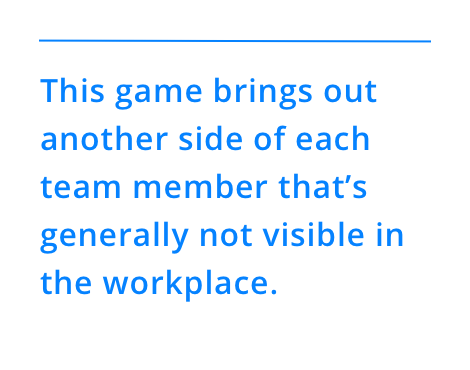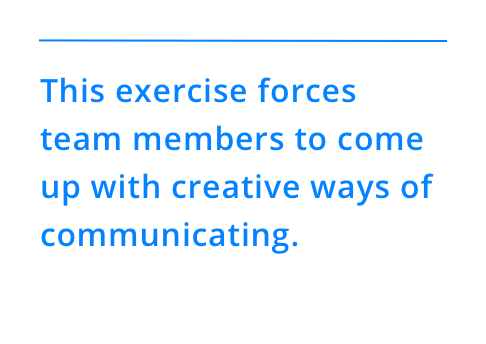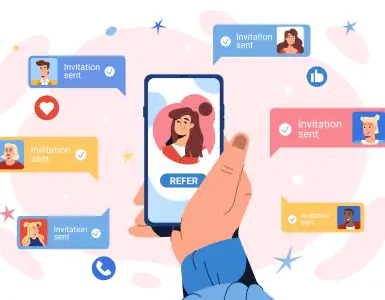Team building games – extroverts dominate them, introverts are embarrassed by them, and pretty much everyone tries to avoid them!
It’s not that corporate team building games are not enjoyable. They can be fun, educational, and bring the participants in touch with the softer side of each other, ultimately turning them into a well-oiled machine-like team at the workplace.
However, office team building activities oftentimes fail because of poor planning. For instance, the worst thing that you can do to someone who is shy of people is to put the spotlight on them before they are comfortable with others in the room. “Hey, introduce yourself to others”, is a surefire way to kill the mood. Never start with something personal!

Here are some fun team building exercises for work that your team will not run away from.
The Ice-Breakers and Confidence-Builders
Activity #1: The Human Knot
Time Required: 15 Minutes
Ideal Number of Participants: 10-20
Objective: Ice-breaker game that also improves communication.
The game’s rules are simple. Get a fairly large team of participants to stand in a circle, closely, shoulder to shoulder. Each person should extend their right hand forward and grab a random person’s hand. Then, they all extend their left hand forward and grab another random person’s left hand. The goal is to untangle their knot of arms without releasing their hands.
The game gets team members involved without putting any spotlight on any of them. Before they know it, they’ll start enjoying the game and get in the mood. It’s a great game to start the team building games.
Activity #2: The Mine Field
Time Required: 15 Minutes
Ideal Number of Participants: 6+ (Teams of 2)
Objective: Build confidence in each team-member and get them involved in the games, while improving communication between each other.
When you want your team members to interact with each other in a more open and friendly environment, go beyond the indoor team building games. Take Mine Field, for example. It is best played in a large open area like parking lot, resort park, or a ground. Place a variety of objects across the open space. Split the participants into teams of two. Let them choose their team-members so that they can be comfortable with each other. Now, one of the participants blindfolds the other and then moves to the other side of the open space. They are now on two sides of the open space.
The goal is to get the blindfolded person to the other side of the open space without them touching any of the objects strewn across it. The other person can only use verbal communication, while the blindfolded person cannot speak.
Being blindfolded, they are vulnerable, and must trust the other person to help them navigate. It helps in building trust between the participants. Also, the game is pretty easy and builds confidence in the team-members about their abilities in general.
Activity #3: A Shrinking Vessel
Time Required: 20 Minutes
Ideal Number of Participants: 8-15
Objective: To get the team members comfortable with each other and solve problems creatively.
Spread a blanket on the floor and ask the team members to stand inside it. Use a rope and tape to mark the boundaries of the area on the blanket within which the team members are allowed to stand. Shrink the allowed space progressively step by step. The team members must come up with creative ideas to make room for each other within the permitted space. It’s a fast-paced game and the team members must think fast to solve the problems.
The fast-paced game gets everyone involved and coordinating with each other instantly. As they start getting results, it serves as positive reinforcement for engaging with each other more. Its’ a powerful ice-breaker game and team building exercise for large teams.
Perception Reforming Games
Activity #4: Find the Common Thread
Time Required: Potentially Full Day
Ideal Number of Participants: 16+ (Teams of 4 or More)
Objective: Break the stereotypes and perceptions team members have about each other and developer broader perspectives about people and their behavior.
Divide the teams into medium-sized groups of 4 to 6 people. Ask each team to find a common thread connecting their members – a hobby, food they love, idiosyncrasy, or something else. Once they settle on the thing that connects them, they create a list of stereotypical qualities of such people. When they are ready, they announce to the other groups who they are.
For the rest of the session, or the day, they enact those stereotypes. For instance, if they are a group of “animal lovers”, they try to express their love for animals in every conversation. They try to inspire their colleagues to adopt animals, contribute to their preservation, or give up non-vegetarianism.
As one of the more serious team games, it forces everyone to confront the subtle stereotypes they have about people and how, if they were true, their workplace environment would be vastly suffocating. It also gets team members to find something that connects them and that can build stronger bonds between them.
Activity #5: Truth and Lies
Time Required: 10 Minutes
Ideal Number of Participants: 5-10
Objective: Reform existing perceptions of team members about each other and help them know each other better
Create small teams of people and get the members to sit in a circle. Each of them should come up with 2 truths and 1 lie about themselves. The lie should not be easy to guess; it should not be extravagant. It should be realistic. Once everyone is ready, ask each team member to state all 3 statements as facts. Others should guess which of them is a lie. Once everyone shares their views, the person can reveal the lie.
The game inspires team members to confront the fact that each of them brings with them a vast amount of life experiences and simplistic stereotypes cannot summarize them. It prompts them to view each other in new light. This is also a great ice-breaker for introverts.
Activity #6: Battle of the Bands
Time Required: 1 Hour or More
Ideal Number of Participants: 12-20 (Teams of 3-5)
Objective: To help team members see each other as people with complex lives, having a variety of skills and hobbies.

This game brings out another side of each team member that’s generally not visible in the workplace. It will change everyone’s perceptions about each other. In addition, the spotlight offers the introverts come out of their cocoons and develop a stronger connection with everyone present.
Team Bonding Games
Activity #7: Virtual Murder Mystery Party
Time Required: Ranges, typically starting around one hour
Ideal Number of Participants: Small groups, ideally less than 8-10 people each
Objective: Collaborate as a team to uncover “whodunnit” through clues
Go beyond the typical virtual happy hour and host a virtual murder mystery party. You’ll give participants a chance to collaborate in a new way — by solving a murder mystery. Not sure how you’d organize such an event? There are plenty of out-of-the-box options for setting up your mystery party. In fact, SnackNation shares 27 ways to host a virtual murder mystery party, from cowboy-riddled mysteries in the Wild West to murder mysteries that incorporate scavenger hunts right at home. The piece also offers logistical tips on hosting.
Activity #8: Office Trivia
Time Required: 10 Minutes
Ideal Number of Participants: 5-20 (Teams of 2-3)
Objective: Help team members realize how observant they are about their workplace and colleagues
Create 20-25 questions about the workplace. It is better if most of them are fairly simple. You can add a few difficult questions to make things interesting. The questions can be about the workplace – the color of tiles, the month with highest birthdays, and so on. Alternatively, they can be about people – who is the most hard-working, the most adventurous, the most meticulous, and so on. The team that gets the highest number of right answers wins.
Simple and fun team games like these are outstanding choices for getting participation from all quarters.
Activity #9: Winner/Loser
Time Required: 5 Minutes
Ideal Number of Participants: 6-10 (Teams of 2)
Objective: Help them see shared experiences in new light and bond with each other.
Divide the group into small teams of 2. Each member should talk about a shared experience they had together. The trick is that one team member discusses the experience with an emphasis on the negative aspects of it, while the other team member focuses on the positive aspects of it. Once they are done, they reverse their roles.
This is one of the best team building activities for adults. It encourages team members to find silver linings in a negative situation and discover opportunities in trying circumstances. It also helps them bond with each other better as they realize what that particular experience meant for them.
Activity #10: Perfect Square
Time Required: 15 Minutes
Ideal Number of Participants: More the Merrier
Objective: To improve interpersonal communication, skills, and trust among participants.
Get everyone to sit or stand in a big circle. Take a big rope and tie its ends together. Now, place the rope in each person’s hands in the circle. Blindfold all of them and instruct them to create a perfect square out of the provided rope without removing the blindfolds.

This exercise forces team members to come up with creative ways of communicating. Some team members will inevitably take up leadership roles and direct others. At the same time, some others will want to be directed. The entire exercise builds trust among the participants.
Team Building Games that Spark Creativity & Ideas
Activity #11: Shark Tank
Time Required: 30-60 Minutes
Ideal Number of Participants: 12-20 (teams of 3 to 5)
Objective: This game inspires innovation, entrepreneurship, and customer-oriented thinking. It also helps the teams recognize hidden talent in the team members.
The game is inspired by the eponymous TV show. Create multiple teams of participants and ask them to come up with a product or service idea. Their task would be to identify an unmet need in the market, and define the product that addresses the need. If the teams are cross-functional, then they can be asked to create a marketing plan, slogan, brand name, and even a financial strategy. They’ll then pitch their product idea to you – The Shark. You can decide whether to invest your imaginary money on their idea, and if yes, how much. The team with the highest investment wins the game.
This game sparks big thinking and allows every team member to contribute in a way that matches their skills and abilities. It also fires healthy competition between the teams. Who knows, they might even end up looking for the next team building exercise! That would be a massive success, wouldn’t it?
Activity #12: Spectrum Mapping
Time Required: 30-60 Minutes
Ideal Number of Participants: 12-20 (teams of 3 to 5)
Objective: To broaden the horizons of participants’ thinking and help them realize the complexity of a problem, while allowing them to come up with unconventional solutions.
Spectrum Mapping is one of those team building games for adults that implores them to come out of their comfort zone. Propose a problem – social, economic, or on some other topic – to the participants and ask them to recommend a solution to address the problem. Map each solution on a spectrum or a 4-quadrant graph on different factors – soft to aggressive, safe to risky, and other factors.
Use post it notes with the ideas to make their position on the spectrum or graph. Bring same or similar ideas together into groups. This will help you identify the popularity of particular sets of ideas.
The game allows others to see that there are other ideas in other quadrants that may solve the problem in a different way. The game also provides insights into the priorities underlying the approach of their team members and help them understand each other better.
Activity #13: Build Bridges, Not Walls
Time Required: 1+ hour
Ideal Number of Participants: 8-20 (teams of 2, 4 or 6)
Objective: To teach teams to collaborate better.
Divide all participants into even numbered groups. Subdivide each group in a pair of teams. Each team is tasked with designing and building one half of a bridge using provided materials – straws, cardboard, polystyrene, Legos, or some other material. Each team gets 10 minutes to design a bridge and another 30 minutes to build it.
The caveat is that no table is able to see what their paired team is building. However, representatives from each team can come together and communicate verbally. They cannot see the work of each other’s team.
After the individual half bridges are ready, the paired teams get another 20 minutes to find a creative solution to make each other’s bridge fit together and complete the structure.
The game brings out problem-solving skills of the team members, and teaches them to collaborate under limited communication channels.
Final Thoughts
The secret to making office team building games exciting for everyone is to get everyone involved. Not asking them to get involved! But, to actually get them involved in an organic way. Help the team members shed their shyness and encourage them to engage with others organically. Create fun team bonding games and an environment where they don’t feel subverted or undermined.





























